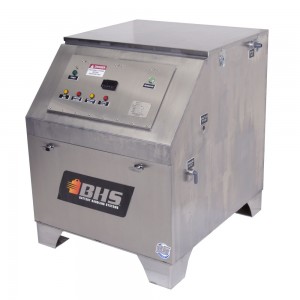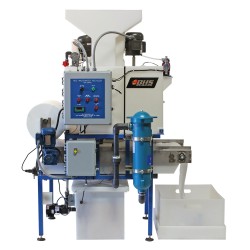We use cookies to make your experience better. To comply with the new e-Privacy directive, we need to ask for your consent to set the cookies. Learn more.
Comparing the BHS Wastewater Recycling System and the BHS Recirculation/Neutralization System
BHS offers a complete line of wastewater treatment products to safely process the runoff from battery washes. Depending on the volume of wastewater an operation generates — and the specifics of the given battery fleet — the most cost-effective solution will vary, but facilities of every size can implement an EPA-compliant wastewater disposal plan with equipment from BHS.
BHS wastewater treatment products can be generally separated into two product lines: Recirculation/Neutralization Systems (RNS) and Wastewater Recycling Systems (WRS). Each of these categories includes a range of models and customizable options.
This document will compare the two product classes to help administrators implement a wastewater management strategy that provides the greatest possible ROI — without running afoul of the EPA or regional environmental regulations.
Summary: The Key Difference Between the RNS and the WRS
The most important difference between the two families of equipment is simple: the WRS provides the dual benefits of recirculation and in-house wastewater disposal, whereas the RNS recirculates water that should not be disposed of without further treatment. Both systems integrate with BHS Battery Wash Cabinets (BWC) to create a closed-loop washing resource, but operations that are outfitted with an RNS still periodically need to hire a third-party disposal service to treat the hazardous waste generated by washing industrial batteries.
Put another way, the WRS provides a complete water treatment solution; the by-products of its processes are completely safe to dispose of conventionally, or to reuse in multiple washes. After a tank of battery wash water travels through the WRS, it is safe — and legal — to enter any municipal sewer system.
By contrast, the RNS does not create by-products that are safe for conventional disposal. Instead, the RNS allows companies to use the same volume of recirculated water in wash after wash. At some point, however, staff will need to flush the system. That still leaves the operation with a tank of contaminated water that cannot go down the drain.
Each system offers its own suite of benefits, and some of them overlap. To further clarify the intended use of these very different products, though, it will be instructive to look at each system individually.

Figure 1. The BHS Recirculation / Neutralization System (RNS-4-SS pictured) controls, filters and recirculates water used for cleaning industrial batteries. The RNS-4-SS comes standard with a 200 gal (757 L) tank, a spray wand with a 10′ (3 m) hose, and a 12 V dc sump pump with float switch.
Recirculation/Neutralization Systems
The RNS provides an ideal solution for operations that have lighter wastewater disposal needs, or that have certain limitations in the battery room. Because of the closed-loop system, an RNS allows staff to wash batteries without the need for floor drains or a continuous water source.
The RNS recirculates water until the filters need to be replaced, greatly extending intervals between disposal. This significantly reduces waste-handling costs and conserves water.
The RNS works with a Battery Wash Cabinet to form a four-step looping system:
-
Clean water from the RNS polyethylene tank is pumped into the BWC.
Every RNS system includes a 12 volt DC sump pump with a float switch to automatically transfer contents into wash cabinets. A 10’ hose also allows staff to manually wash batteries.
-
The BWC thoroughly washes forklift batteries, collecting the runoff in a reservoir.
These durable stainless steel cabinets spray off batteries, running cases through an electrolyte neutralizing cycle to thoroughly remove acidic residue. Options include an automatic scrub brush and an air compressor that reduces drying times significantly.
-
Dirty water re-enters the empty tank in the RNS.
Because the system is entirely enclosed, staff will not face the danger of contact with hazardous wastewater. The RNS-1 comes standard with a 125 gallon polyethylene tank, while the RNS-3 and RNS-4 models incorporate 200 gallon integral tanks.
-
The RNS automatically filters harmful particles out of the water, and reactants bring the pH level back to normal.
Some models are equipped with a built-in ozone purification system, which further cleanses wash water. Once this step is complete, the system is ready to clean more batteries, starting the circular process over again.
Enterprises that profit from a BHS Recirculation/Neutralization System include:
Warehouses with small to moderate electric forklift fleets, manufacturing facilities with a dedicated battery room, and general industry.
Wastewater Recycling Systems
The WRS automates wastewater purification to limit required staff time, and all of the by-products of the process are completely safe for the sewer or the landfill.
Specific benefits of the WRS include:
-
Preparation of wastewater for conventional disposal.
The WRS runs wastewater through a purification process that ends with two by-products: clean water and a bentonite clay tablet that safely seals pollutants so that they will never leach into groundwater. These by-products meet all EPA and regional guidelines for safe entry to sewer systems and landfills. Operations with these systems can avoid EPA fines without having to hire costly third-party waste disposal companies.
-
Portable tanks.
The WRS-2 KIT comes complete with two 330 gallon portable water tanks. That empowers businesses to cart a tank of clean water to a customer’s facility, wash their batteries on-site, and transport the resulting wastewater back to the WRS unit itself for safe, legal disposal.
In short, the WRS-2-KIT allows battery dealers or other industrial equipment professionals to provide a much-needed service for their customers.
-
Quick, automatic wastewater treatment.
Some wastewater recycling systems require constant attention from staff; not the WRS. Operators simply fill the tank with dirty water and the automated system will process the water at a rate of two gallons per minute.
Cleaned water can either be reused in a closed-loop system like the one provided by the RNS, or staff can pour it down the drain.
-
Independent lab testing.
Specialists test all by-products to ensure that they meet all federal and local regulations for disposal.
Independent lab technicians even research municipal standards for safe waste disposal and calibrate the system to keep the recipient from running afoul of environmental regulations of any kind. This value-added service is included with every purchase of a WRS.
-
Comprehensive alarms limit monitoring requirements.
The WRS is designed to automate the wastewater treatment process as much as possible. To this end, the system includes numerous audible and visual alarm systems that will alert staff to any maintenance that may be required.
When supplies run low, the system will call the operator’s attention to that fact before continuing treatment; this frees staff to perform other duties rather than monitoring the entire treatment process.

Figure 2. The BHS Wastewater Recycling System (WRS) is an automated, single structure, recycling system, providing on-site wastewater management. The WRS treats, filters and processes industrial wastewater to remove hazardous contaminants and particulates, ensuring that the recycled water is clean.
Enterprises that profit from a BHS Wastewater Recycling System include:
Warehouses with large electric forklift fleets, industrial battery dealers and rental houses, metal fabricators, general metal work, metal finishing/polishing, die casting, plating, truck wash centers, painting/screening/coating, general industry and manufacturing.
The Cost of Improper Wastewater Disposal
The EPA heavily regulates the runoff from industrial batteries. This wastewater meets the technical definition of “hazardous waste,” which triggers a whole suite of federal regulatory practices.
Subtitle C of the federal Resource Conservation and Recovery Act established a detailed protocol that allows the EPA to track hazardous waste across its entire lifespan, from production to disposal. If solid waste eventually leaches into groundwater, creating potentially harmful pollution, the EPA should be able to trace the dangerous substance back to the facility that generated it — and hold the polluter accountable.
Industry publication The Environmental Daily Advisor warns about seven violations that the RCRA lists as criminal actions. These violations could carry fines of up to $50,000 per day and/or a maximum of 5 years in jail. Given the levels of lead, acid and heavy metals found in most battery wash water, managers could risk these penalties if they mishandle the substance in any of these ways:
- Failure to comply with the RCRA’s reporting guidelines.
- Transportation of battery wastewater to non-compliant facilities.
- Treatment of wastewater without a permit.
- Falsifying documents related to hazardous waste handling.
- Moving hazardous waste without a manifest when required.
- Placing staff or residents in danger of bodily injury or death through the transportation, treatment, storage, or disposal of wastewater.
- Attempting to export waste without complying with U.S. international agreements.
Given the high stakes of improper disposal, every operation needs an RCRA-compliant wastewater treatment plan in place before washing industrial batteries. If that plan is to outsource treatment to a third-party company, installing a Recirculation/Neutralization System from BHS in the battery room will lead to lower costs and greater environmental benefits over time.
For facilities that generate hundreds of gallons of runoff from battery washes every month, on the other hand, the BHS Wastewater Recycling System provides a complete in-house wastewater disposal solution.
References:
Esworthy, Robert. “Federal Pollution Control Laws: How Are They Enforced?” Congressional Research Service, 7 Oct. 2014. PDF. 24 Nov. 2015.
“Hazardous Waste - RCRA Subtitle C.” EPA. U.S. Environmental Protection Agency, n.d. Web. 28 Oct. 2015.
Lagana, Kelly. “7 RCRA Violations That Will Send You to Jail.” envirodailyadvisor. BLR, 3 August 2012. Web. 26 Oct. 2015.
“RCRA Orientation Manual 2014.” EPA. U.S. Environmental Protection Agency, 2014. PDF. 28 Oct. 2015.

